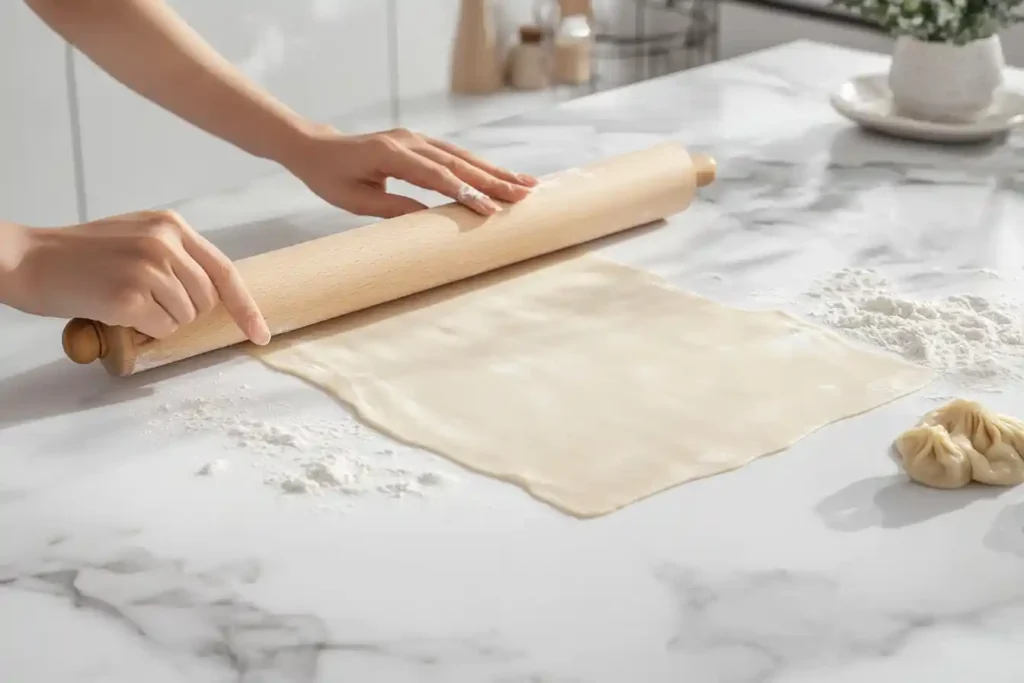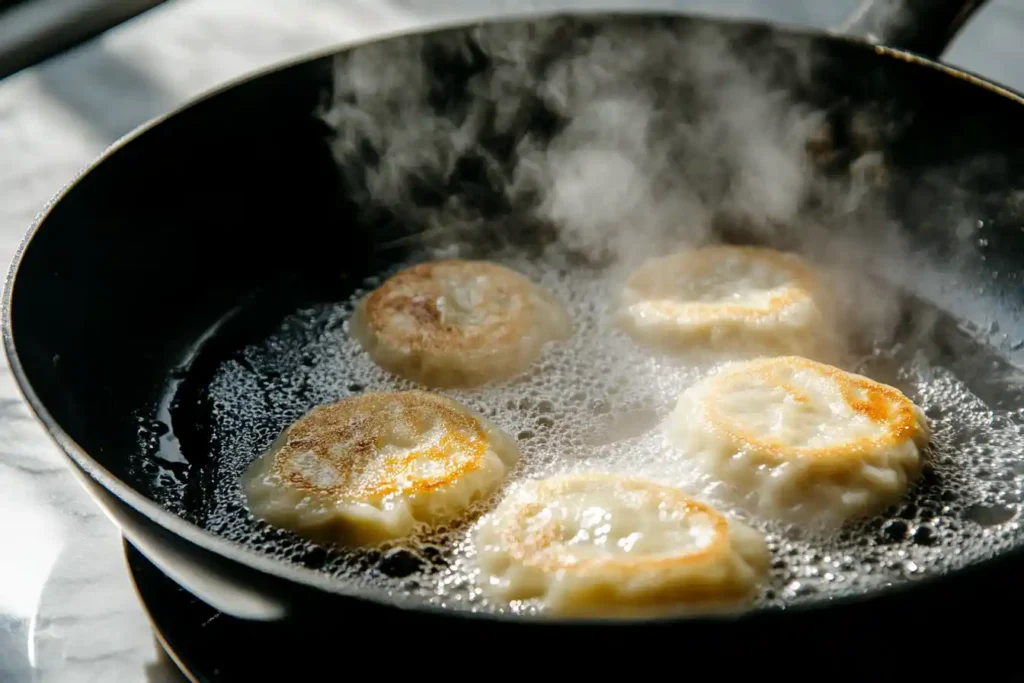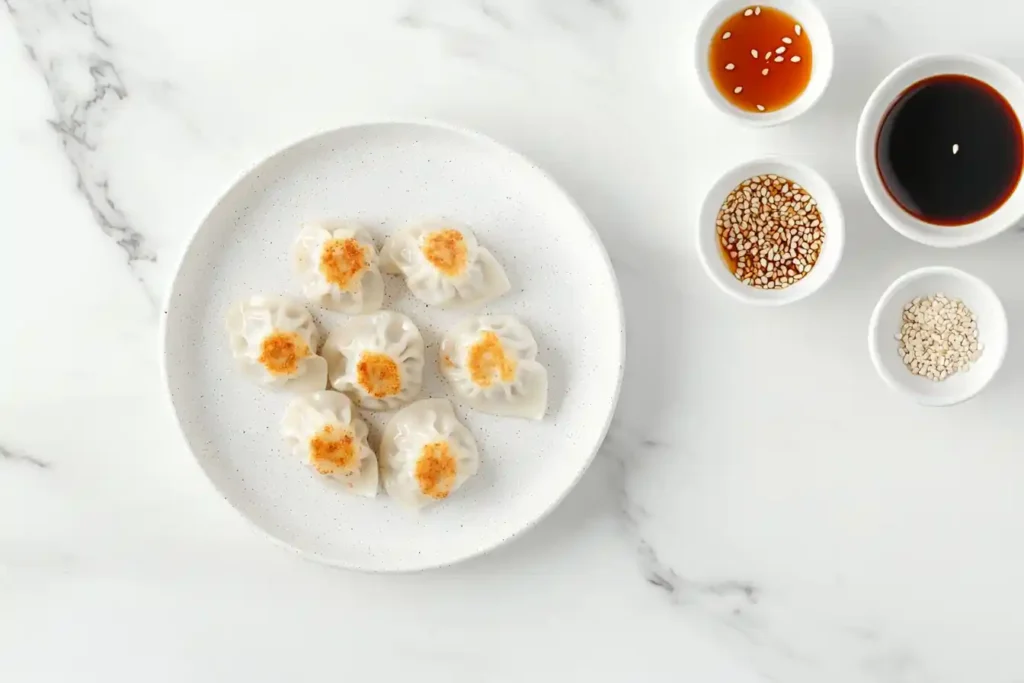Introduction
Dumplings have been a beloved comfort food in many cultures, and the bottom dumpling is no exception. Known for its golden, crispy base and soft, tender top, this dish is the perfect combination of texture and flavor. Whether you’re new to cooking or a seasoned chef, mastering bottom dumplings is a culinary skill worth having. In this article, we’ll explore the origins of bottom dumplings, guide you through creating your own, and share tips to make them just right. Plus, we’ll dive into creative variations and serving suggestions to keep things exciting. Let’s get started!
What Are Bottom Dumplings?
History and Origin of Bottom Dumplings
Bottom dumplings have roots in several cuisines, but they’re most notably associated with Asian cooking, particularly Chinese potstickers. Traditionally, these dumplings were made to utilize leftovers, combining dough and filling into a simple, hearty dish. Over time, they evolved into a favorite, celebrated for their unique cooking method that achieves a crispy bottom and soft top.
Characteristics of Bottom Dumplings
What sets bottom dumplings apart from other varieties is their delightful texture. When prepared correctly, they feature a crisp, golden crust on the bottom, thanks to pan-frying, while the tops remain soft and pillowy from steaming. In terms of flavor, bottom dumplings are highly versatile, ranging from savory meat fillings to vegetarian options. This combination of textures and flavors makes them an irresistible treat for any meal.
Ingredients for Bottom Dumplings
Essential Components for Crispy Bottom Dumplings
To create the perfect bottom dumpling, you’ll need a few simple ingredients that come together to form a harmonious blend of flavors and textures. Here’s what you’ll need for the dough and filling:
Dough Ingredients:
- 2 cups all-purpose flour
- ¾ cup warm water
- A pinch of salt
Filling Ingredients:
- 1 cup ground chicken or tofu (for a vegetarian option)
- 1 cup finely chopped cabbage
- ½ cup grated carrots
- 2 green onions, finely chopped
- 1 teaspoon minced garlic
- 1 teaspoon minced ginger
- 1 tablespoon soy sauce
- 1 teaspoon sesame oil
- A pinch of black pepper
Optional Additions:
- Chopped mushrooms for an earthy flavor
- A dash of chili flakes for spice lovers
Optional Add-Ins for Flavorful Dumpling Fillings
For extra customization, consider adding herbs or spices that complement your filling. For example, cilantro can bring a refreshing touch, while a sprinkle of five-spice powder adds depth. If you’re catering to dietary preferences, swap the all-purpose flour for gluten-free flour or use plant-based proteins in the filling.
Step-by-Step Guide to Making Bottom Dumplings
How to Prepare the Dough for Bottom Dumplings
- Combine the Ingredients: In a large mixing bowl, mix the flour and salt. Slowly pour in the warm water while stirring with a spoon or your hand.
- Knead the Dough: Once the mixture comes together, transfer it to a floured surface and knead for about 8 minutes until smooth and elastic. Cover with a damp cloth and let it rest for 30 minutes.
Filling Techniques for Soft and Crispy Dumplings
- Prepare the Vegetables: Finely chop the cabbage, carrots, and green onions. Grate the ginger and mince the garlic.
- Combine Ingredients: In a mixing bowl, combine the prepared vegetables with your protein choice. Add soy sauce, sesame oil, garlic, ginger, and black pepper. Mix thoroughly.
Shaping the Dumplings
- Roll Out the Dough: Divide the dough into small balls and roll each into a thin circle about 3 inches in diameter.
- Fill the Dumplings: Place a teaspoon of filling in the center of each circle. Fold the dough over to create a half-moon shape, and press the edges together to seal. For extra flair, crimp the edges with your fingers or a fork.
Cooking Tips to Achieve Golden-Brown Bottom Dumplings
- Pan-Fry the Bottoms: Heat a non-stick skillet over medium heat and add a tablespoon of oil. Place the dumplings flat-side down and cook for 2-3 minutes until the bottoms turn golden brown.
- Steam to Finish: Add ¼ cup of water to the pan and cover with a lid. Steam the dumplings for 5 minutes until the tops are soft and the filling is cooked through.
- Serve Hot: Remove the lid and let any remaining water evaporate. Transfer the dumplings to a plate and serve immediately.

For more inspiration on dumpling-making techniques, check out our Dumpling Recipes Guide!.
Nutritional Information for Bottom Dumplings
Nutritional Benefits of Bottom Dumplings
The bottom dumpling is not only delicious but also packed with nutritional value, depending on the ingredients used. For instance, incorporating lean proteins and fresh vegetables provides a good balance of nutrients. Additionally, the dough contributes carbohydrates, offering energy, while vegetables add fiber and essential vitamins.
Nutritional Content (Per 100g)
Here’s a breakdown of the nutritional information for a standard serving of bottom dumplings:
| Nutrient | Amount (per 100g) |
|---|---|
| Calories | 220 |
| Protein | 8g |
| Carbohydrates | 30g |
| Fat | 7g |
| Fiber | 3g |
| Sodium | 400mg |
To make them healthier, consider reducing the sodium by using low-sodium soy sauce or adding more vegetables for a fiber boost.

Serving Suggestions for Bottom Dumplings
Best Pairings for Bottom Dumplings
The bottom dumpling is versatile and pairs wonderfully with a variety of sides and sauces. For example, a tangy soy-vinegar dipping sauce enhances the savory flavor. For a spicier kick, serve with chili oil or sriracha.
In addition, pairing dumplings with a bowl of hot soup, such as miso or chicken broth, makes for a comforting meal. Alternatively, a side of steamed greens or a light salad balances the richness of the dumplings.
Presentation Ideas
How you present your bottom dumplings can elevate the dining experience. For a party platter, arrange the dumplings in a circular pattern on a large plate and garnish with sesame seeds and chopped green onions. Alternatively, stack the dumplings neatly and serve with dipping sauces in small bowls for an elegant look.
For a casual setting, serve the dumplings in bamboo steamers for an authentic feel. Add a small bowl of sauce in the center for easy dipping. These presentation ideas ensure your dumplings look as good as they taste.
Explore more creative serving ideas on our Recipe Inspiration Page.

Variations of the Classic Bottom Dumpling Recipe
Vegetarian Options for Bottom Dumplings
Bottom dumplings are incredibly versatile, making it easy to adapt them for vegetarian or vegan diets. For a plant-based version, replace the meat filling with tofu, tempeh, or a mix of finely chopped mushrooms and water chestnuts. Additionally, seasoning the filling with soy sauce, sesame oil, and a touch of garlic or ginger ensures bold and savory flavors.
For even more variety, add colorful vegetables like bell peppers, spinach, or corn to the filling. These ingredients not only enhance the flavor but also boost the nutritional value. Pairing these dumplings with a vegan-friendly dipping sauce, such as a mix of tamari and rice vinegar, completes the dish.
Global Flavors for Unique Dumpling Creations
Bottom dumplings can take on flavors from around the world. For instance, incorporating spices like cumin, coriander, or curry powder gives them a Middle Eastern or Indian twist. On the other hand, adding cheese and herbs like parsley or oregano can create a Mediterranean-inspired dumpling.
For those who enjoy bold flavors, experiment with Korean-inspired fillings, such as kimchi and ground pork, or Mexican flavors with black beans, jalapeños, and shredded cheese. These global influences turn the classic bottom dumpling into an exciting and customizable dish that everyone can enjoy.
Troubleshooting Your Bottom Dumpling Recipe
Common Issues with Cooking Bottom Dumplings
Creating the perfect bottom dumpling requires attention to detail, but certain common mistakes can easily derail the process. First and foremost, overfilling the dumplings is a frequent error. Adding too much filling makes it difficult to seal the dumpling properly, which can cause it to burst open during cooking. To avoid this, use only about a teaspoon of filling and press the edges firmly to seal.
Another issue is dough that’s too thick, which results in chewy dumplings that lack the desired delicate texture. For best results, roll the dough to about 1/8 inch thick, ensuring it’s even throughout. Additionally, failing to preheat your skillet adequately can lead to sticking or uneven browning. To fix this, always heat the pan thoroughly before adding oil and dumplings.
Crowding the pan is another pitfall to avoid. Overcrowding prevents proper heat distribution, leaving some dumplings undercooked. Cook in smaller batches to ensure every dumpling cooks evenly. Finally, using too much water during the steaming process can make the dumplings soggy instead of tender. To prevent this, measure the water carefully and allow it to fully evaporate during the cooking process.
Quick Fixes to Perfect Your Dumpling Texture
Even if mistakes happen, many issues with bottom dumplings can be salvaged. For instance, if your dumplings stick to the pan, carefully slide a spatula underneath while adding a splash of water to loosen them. This can prevent tearing while maintaining their crispy bottoms.
If the dumplings are too chewy, it may be due to overmixing the dough. To fix this for future batches, knead the dough just until smooth and let it rest for at least 30 minutes before rolling it out. In addition, if the filling seems dry, mix in a small amount of broth or soy sauce to add moisture and flavor.
For dumplings that have burst, you can still save the filling and repurpose it for a stir-fry or as a topping for rice or noodles. This way, nothing goes to waste, and you still get to enjoy the delicious flavors.
Pro Tips for Mastering Bottom Dumplings
To elevate your dumpling-making skills, a few pro tips can make all the difference. For example, lightly flouring your rolling pin and work surface ensures the dough doesn’t stick, making it easier to handle. Additionally, using a dumpling mold can speed up the process and help create uniform shapes, which cook more evenly.
For perfect crispy bottoms, avoid lifting the dumplings too early during frying. Allow them to cook undisturbed for 2-3 minutes to form a golden crust before adding water for steaming. Finally, experiment with different cooking oils, such as sesame or vegetable oil, to enhance the flavor and aroma.
By keeping these tips and troubleshooting strategies in mind, you’ll gain confidence in making bottom dumplings that look and taste amazing. Mastering these techniques ensures every batch is a success, no matter the occasion.
FAQs About Bottom Dumplings
What Makes Bottom Dumplings Unique Compared to Other Dumplings?
The bottom dumpling stands out due to its distinctive cooking method that combines frying and steaming. Unlike traditional dumplings, the bottom is pan-fried until golden and crispy, while the rest of the dumpling is gently steamed to retain its soft texture. This contrast in textures makes them a favorite for many.
Can Bottom Dumplings Be Frozen for Later Use?
Absolutely! Bottom dumplings freeze exceptionally well. To do this, lay uncooked dumplings on a baking sheet in a single layer and freeze until solid. Once frozen, transfer them to a sealed bag or container. When ready to cook, there’s no need to thaw—simply cook from frozen, adding a few extra minutes to the steaming time.
What’s the Best Way to Reheat Bottom Dumplings?
To reheat bottom dumplings, the best approach is to use a skillet. Add a little oil, place the dumplings flat-side down, and reheat over medium heat until warm and crispy. Avoid microwaving, as it can make the dumplings soggy and unevenly heated.
How Can I Make Gluten-Free Bottom Dumplings?
Making gluten-free bottom dumplings is simple by substituting regular flour with gluten-free all-purpose flour. Additionally, ensure your soy sauce and other seasonings are gluten-free. The result is a dumpling that’s just as tasty and satisfying as the original.
Conclusion and Final Tips
Why Bottom Dumplings Are Worth the Effort
Mastering the bottom dumpling is not just about creating a dish; it’s about crafting an experience. These dumplings bring together a crispy base, tender tops, and flavorful fillings in a way that few dishes can match. In addition, the act of making them is a fun and fulfilling process that allows you to connect with the culinary traditions of different cultures. Whether you’re preparing a quiet dinner for your family or entertaining guests, bottom dumplings are sure to leave a lasting impression.
What makes these dumplings truly special is their adaptability. They can be tailored to suit a variety of tastes, dietary restrictions, and occasions. For instance, by simply switching up the filling or experimenting with new dipping sauces, you can create an entirely fresh experience with each batch.
Tips for Making Your Bottom Dumplings Unique
If you’re looking to take your bottom dumpling game to the next level, creativity is key. Consider these tips for elevating your recipe:
- Try Unique Fillings: Go beyond traditional meats and vegetables by incorporating bold flavors like smoked salmon, goat cheese, or roasted garlic. For a vegan twist, use mashed sweet potatoes or lentils spiced with cumin and paprika.
- Experiment with Dough: Add herbs like parsley or dill to the dough for a pop of flavor. Alternatively, try using whole wheat or rice flour for a different texture.
- Infuse the Cooking Oil: Before frying the dumplings, flavor the oil with garlic, ginger, or chili for an aromatic twist that enhances every bite.
Moreover, don’t overlook the power of presentation. Beautifully arranged dumplings garnished with sesame seeds, scallions, or edible flowers can transform a simple dish into a show-stopping centerpiece.
Serving Suggestions to Impress
When it’s time to serve your bottom dumplings, presentation and pairing can make all the difference. For casual dining, offer an assortment of dipping sauces, such as soy-ginger, peanut, or spicy sesame, allowing guests to mix and match flavors. On the other hand, for a more formal affair, consider plating the dumplings in a circle around a bowl of sauce for an elegant display.
Pair the dumplings with sides that enhance their flavors. For example, a light Asian-style cucumber salad or steamed bok choy balances the richness of the dumplings. Additionally, a warm soup, such as miso or wonton, creates a comforting and cohesive meal.
Encouragement for Your Dumpling Journey
Creating bottom dumplings at home might seem intimidating at first, but with a bit of practice, it becomes a highly rewarding skill. Start small, perfecting the basics of dough preparation and folding techniques. Once you feel confident, experiment with fillings and cooking styles to discover your signature dumpling.
Moreover, involve your family or friends in the process. Dumpling-making is a great group activity that turns cooking into a shared experience. Not only do you get to enjoy delicious food, but you also create lasting memories in the process.
Final Thoughts
Making bottom dumplings is more than just preparing a meal—it’s an adventure in creativity, flavor, and cultural appreciation. Whether you’re keeping it simple or going all out with innovative fillings and presentations, these dumplings are sure to become a staple in your kitchen.
So, roll up your sleeves, gather your ingredients, and embrace the art of dumpling-making. With every batch, you’ll refine your skills and create a dish that’s as beautiful as it is delicious. Let the journey begin!

